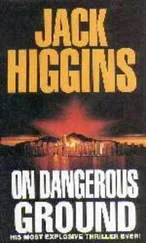“Yes. Steer toward it, but keep about a ten-degree offset.”
“Steer toward with a ten-degree offset, U-bay aye.”
“Slow down now,” Richards directed. “Make your speed four knots.”
“Four knots, aye.” They were still five hundred yards off. All he could see on the sonar was a jumble of shapes.
“Circle it. Maybe it’ll be clearer from another angle.”
“Circle it, aye,” Mitchell acknowledged.
With a certain amount of grace, Jerry turned the Manta to starboard and made a quarter circle, with the object at the center. He didn’t bother keeping it in the sonar’s detection cone, since the location was marked on his nav display.
When he turned back toward the object, it was longer, and the jumble had resolved into separate objects lying near and on the large object. It was more than large. Figuring the range and the angle it covered, it had to be almost a hundred feet long.
“Continue to circle,” Richards ordered and Jerry turned the Manta to the right again. The Manta had no camera, in fact, no other sensors besides the sonar. Jerry imagined the discussion in control. What was it? Was it worth finding out? Could this be part of Delta One? Jerry didn’t think so. Large as it was, it didn’t look like a barge, and it was too big to be one of the containers.
“U-bay, control. Launch ROV and investigate this object. We’re designating it Delta One-Alpha.”
Davis got busy, but forgot to respond until Richards prompted her again. “U-bay, control. Did you receive my last?”
Davis quickly pressed the button on the mouthpiece. “Yes, sorry. I’m launching Huey now.”
“It’ll take an hour for the ROV to get there at six knots,” Jerry reported over the phones. “Should I set up a perimeter patrol?” The procedure they’d decided on yesterday was that when the ROV investigated a site, the Manta would keep watch.
“Wait one,” Richards replied, but almost immediately continued, “Negative. If we’ve got an hour, we want you to continue on to Delta One. It’s close by. That way, when the ROV is finished with Delta One-Alpha, it can continue on to Delta One.”
“Understood. Changing course to two nine zero, heading for Delta One, ETA at eight knots eighteen minutes.”
Jerry flew the Manta carefully over the smoothly rolling bottom. It was less rocky here, with more sand and dirt. He’d only been on his new course for ten minutes when he saw the barge on his sonar display. It showed as another hard return on the sonar display and was a little larger than Delta One-Alpha.
Without a camera, he couldn’t be sure, but the location matched the Russian report, and there was nothing else that large visible on the display. Jerry started the Manta in a slow spiraling circle, centered on the object.
Emily had the ROV about halfway to the mysterious Delta One-Alpha and was refusing Patterson’s demands to increase Huey’s speed. Although the ROV had a top speed of twelve knots, its battery charge only lasted a quarter of the six hours it had at its cruise speed of six knots.
“She should know better,” Davis muttered to Jerry.
Patterson, content to relay orders through Hardy and Richards before, now came on the circuit. “Dr. Davis,” she said sharply, “you have to go faster. We’ve got two sites to investigate now instead of one.”
“Which means we’ll be out longer and need to conserve our battery power,” replied Emily firmly. Jerry was surprised by Emily’s sudden defiance. She’d never stood up to Patterson before.
“We don’t have to go to full speed,” Patterson wheedled. “Just increase to eight or nine knots.”
“Which saves us what? A few minutes? Why are we in such a hurry?”
“This is the very first site. We’ve got a lot to do and I don’t want us falling behind.”
“And I don’t want us losing Huey because he has a flat battery. Delta One-Alpha is on the way to Delta One. We’ll hardly lose any time at all.”
Patterson finally gave up, at least in part because the ROV was close to the object’s position. The ring-laser gyros in both vehicles allowed for precise navigation, and there was no need to search again for Delta One-Alpha.
At three hundred yards, Emily slowed Huey and turned on the lights. The camera showed a clear picture, but even with the lights on there was only a dark green image filled with bright swirling specs flowing by the camera. It looked exactly like a light snowfall in a car’s headlights. As the ROV slowed, the snowflakes slowed as well.
The ROV’s sonar, much weaker than the Manta’s, only had a range of two hundred and fifty yards, intended for close-in navigation. It picked up the object right on schedule, but there was still nothing on the TV camera.
At a hundred yards, she slowed Huey again, creeping forward. Jerry’s eyes were glued to the TV screen, although he forced himself to check the Manta, still circling and searching near Delta One.
At fifty yards, a bright green-gray wall suddenly materialized out of the dark water. Davis stopped the ROV without being told to, and then slowly panned the camera left to right, then up and down.
It was a curved wall, then a cylinder, but an uneven one, with lumps— and a couple of portholes?
Davis said, “I’m moving left. I’m a little closer to that end.”
Richards acknowledged her message and after a short pause, replied, “Go ahead.”
Davis hadn’t waited, though, and the image slid sideways as the ROV passed across it. Almost immediately the cylinder’s shape changed, narrowing, and they could see the familiar outline of a cockpit. “It’s an airplane? Did it crash here?” somebody in the torpedo gang asked.
Emily continued past what they now knew was the nose, and then pivoted Huey so they were looking at the craft head-on. “It’s an An-12 Cub,” Jerry reported over the phones. “It’s a cargo plane, a lot like our C-130 Hercules.”
Now that he knew what it was, Jerry could interpret the image, recognizing many details. The plane was partially covered with marine growth, but on an object of that size a little green fuzz couldn’t hide its identity. The underside of the nose was crumpled and several long cracks in the skin showed that the plane had landed on the seabed with some force.
“Did it crash?” Richards’ question echoed the one in Jerry’s mind.
The ROV was now on the other side, the port side of the aircraft, and she passed it down the plane’s length.
Halfway, Jerry said, “Wait. Stop, please. Can you have the camera point up, toward the top of the fuselage?” Although Emily was nearby, he asked over the circuit so that up in control they’d know what was happening.
Davis moved the ROV up. The image slid down until they were looking at the upper midsection of the fuselage. It bulged and an exposed metal framework marred the smooth surface. “Look, that’s where the wings were removed. It didn’t crash. It was dumped here.”
Jerry’s conclusion was confirmed when the ROV continued aft. One of the plane’s horizontal stabilizers lay next to the fuselage. Its base was a neat line, not jagged. The airfoils had been detached and discarded along with the fuselage.
As she moved aft, the ROV’s gamma detector came off the peg. “I’m getting a reading,” reported Davis. “Just higher than background.”
“Understood,” was Richards’ reply. “Continue aft.”
As Huey slowly approached the tail, the counter continued to rise. “Whoa, it’s coming up fast. Now reading 0.7 rem per hour,” Davis reported.
“That sounds real bad,” Davidson said from his seat at the Manta controls.
“Any radiation is bad,” answered Davis offhandedly “But this wouldn’t cause significant damage if you limited your exposure to a few hours. I wouldn’t go inside the plane, though. Accounting for distance and the shielding properties of water, I’d guess the dose rate would be about fifty times that inside.”
Читать дальше












